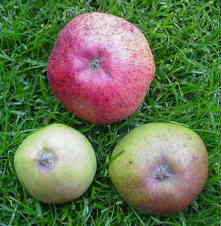
English Apples - Cider Apples
In the last century and in the early part of this, English cider was manufactured from old-fashioned cider apples - often small, hard, yellow apples which differed only a little from crab apples. They were grouped into sweets, sharps, bittersharps, bittersweets. Sharps contain acid, sweets obviously contain sugar, and bitters contain tannin - the three essential components of a good cider. Producing commercial cider involves getting the balance of the three ingredients exactly right, by mixing apples in the correct proportions.
Some of these varieties still exist, but many have disappeared. A number exist in the National Fruit Collection at Brogdale and some are sold by specialist nurseries.
Unlike the old days a major component of today's cider industry is the Bramley, and a typical mass produced cider may contain 40% Bramley juice, which is very acidic, the rest being a mixture of other types - some of them recognised cider varieties.
True cider apples are different to dessert apples in that they contain more tannin, more acid, and coarser flesh. They contain less vitamin C, and although their juice is good, their flavours range from reasonable to uneatable.
Apples (other than Bramley) now used in cider production include:
DABINETT This is a bittersweet apple, attractively colored and sized; similar to Laxton's Fortune in appearance, but a bit greener and darker and sometimes alightly bigger. It's ready early October. Like many bittersweets, it is pleasantly sweeet when you bite into it, but the flesh is coarse, and can't readily be swallowed. Cider apples were developed over the years to be like this, because it made crushing and juice separation easier.
ELLIS BITTERS
Another bittersweet; much larger, beautiful red striped apple
on a light background. It has a pungent small when ripe, and it
tastes both sweet and very astringemt when you bite into it. It is inedible
as a dessert apple. The flesh is extremely coarse and full of tannins.
Ready early October.
MICHELIN
A bittersweet; the "Golden Delicious" of the cider apple world.
A small green apple, rather like a miniature Bramley, but more conical.
Sweet and inedible like Ellis Bitters; it has little
going for it except that the trees are
extremely prolific. Their growth is unusual - the branches
tend towards the vertical, which makes pruning tricky. Some
growers tie the branches in a more horizantal position
but this is a lot of trouble.
ALLINGTON PIPPIN and TOM PUTT have also been used as cider apples. These are sharp, but low in tannin, and they can double as cooking or dessert apples if picked at the correct time.
Here's a picture: from the top, clockwise: Ellis Bitters, Dabinett and Michelin. The linear size has been reduced by a factor of 2, so the Ellis Bitters is about 4 inches across.

Nigel Deacon / Diversity website